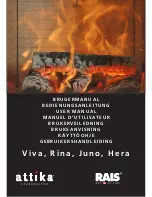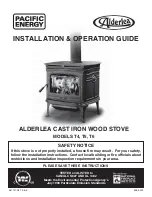
Installation
THE FLUE PIPES ARE THE MOST IMPORTANT COMPONENTS WITH
REGARD TO FIREPLACE SAFETY.
THEY MUST BE INSTALLED STRICTLY ACCORDING TO THE
INSTRUCTIONS AND KEPT AWAY FROM ANY FLAMMABLE MATERIAL.
IN ADDITION, LOCAL BUILDING REGULATIONS AND SAFETY
STANDARDS MUST BE RESPECTED.
1. Choose the location for the stove. If your floor finish is wood, carpet, plastic or any other
flammable material, you must place a steel (or other non-flammable material) base plate under the
stove.
If the wall is made of a flammable material, you must apply the minimum distances shown in the
table below. If you want to position the fireplace closer to the wall, you need to protect the wall with
a metal or non-flammable plate, 10 cm wider and 30 cm higher than the fireplace itself, and
separated from the wall by 3 cm in order to allow free circulation of air.
Distance to Walls
(cm)
Installation
Flue distance
Side distance
Corner distance
With protection
14
7
5
Without protection 28
20
15
2. Locate the centre of the main flue in the ceiling and drill a hole through it and roof. Based on the
Flue Kit diameter that you are using, follow the instructions in the table below:
Flue Kit Diametre
Outer Flue
Hole Diametre in
Outer Roof
Hole Diametre in
Flammable Ceiling
Hole Diametre in
Non-Flammable
Ceiling
5”
8”
21 cm
50 cm
21 cm
6”
10”
26 cm
55 cm
26 cm
If the roof is made of wood, the hole must be covered by a sheet of non-flammable material
(fibre cement or similar, not included in the Flue Kit). Otherwise, follow the guidelines in the table
above closely for the diameter of the holes in the ceiling and roof. In the attic section, place the
outer flue over the main flue and fill the space between the main and outer flue pipes with the rock
wool supplied. No flammable material should be within a 15 cm range of the outer flue. The outer flue
should rest on the ceiling plate and be supported by the roof structure with steel bracing (not
provided).
Summary of Contents for Sedgley
Page 2: ......






























